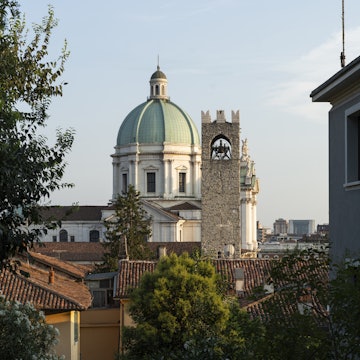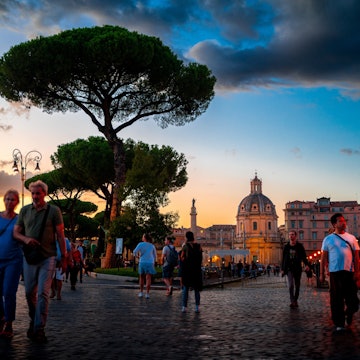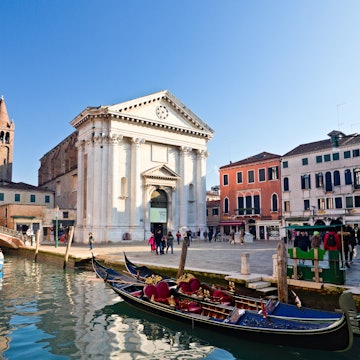

Don't sleep on Slovenia's incredible coastline © AzmanL / Getty Images
Sandwiched between the expansive shores of Italy and Croatia, Slovenia's small, 30-mile strip of Adriatic coast is a balmy contrast to a mainland blanketed in dense foliage and towering mountains.
With languid palm trees, sweeping salt pans and charming seaside towns basking under a mild climate, this unheralded coast is a calming escape from its popular Italian and Croatian neighbors.
Already a diminutive country, you could easily travel the coast in a day, but who would want to do that? Whether soaking in the ethereal views from Piran’s rocky promontory or wandering Koper’s tight medieval streets, there are ample reasons to slow down and enjoy this curious corner of Slovenia.
Here’s everything you need to know about visiting coastal Slovenia.
When should I go to Slovenia’s coast?
Unsurprisingly, things get busy here during the height of summer, though it’s worth noting that many Slovenes skip their own country’s coast in favor of the quieter Croatian beaches of Istria or Dalmatia to the south.
The shoulder seasons and, in particular, the months of April and October are ideal, especially in popular places like picturesque Piran. The streets won’t be as crowded and the weather will still be pleasant, though a jacket in the evening may be required. Hotel prices tend to be more reasonable too.
The Primorska Summer Festival is the prime performing arts event during summer, usually taking place around late July and early August. Look out for concerts, theater performances and dance shows throughout the region.
If visiting between November and March, you might find hotels and restaurants either closed or with severely curtailed opening hours.
How long should I spend on Slovenia’s coast?
Slovenia’s an incredible country with a wide diversity of landscapes for its size, so don't restrict yourself entirely to the coast if you have the time. That said, the coastal region is a unique corner of Slovenia that looks quite different from its hill-strewn mainland.
With only 30 miles to explore, a four-day trip may suffice. Make sure to spend at least a day exploring Piran, while perhaps also dedicating a day to the sandy beaches at Portorož. Moon Bay is more off the beaten track and its pebble beach and craggy cliffs are worth hiking before you leave.

Is it easy to get in and around Slovenia’s coast?
Ljubljana Jože Pučnik Airport will be the first port of call for most visitors and it’s around an hour and a half's drive from there to Koper. An infrequent train also runs from Ljubljana to Koper (usually five per day) and takes between 2 and 2 ½ hours, depending on which service you choose.
The towns along the coast are all compact and walkable, making them perfect for single-day visits.
There are no trains spanning this winding, craggy coast but buses do run between Koper and Piran, taking in Portorož and Izola. However, they aren’t regular and visitors may be better served hiring a car for the duration of their time here.
Top things to do on Slovenia’s coast
Wander through Koper's winding streets
Start in Koper, the region’s biggest city, and explore its web of medieval back streets teeming with quirky stores like salt fusion specialists Barba Salt. See those narrow streets fanning out from above by walking up the stone steps of the 54-meter-high, 15th-century Bell Tower in Tito Square, where the peach-tiled roofs of the Old Town give way eventually to mist-covered mountains to the east and the Gulf of Trieste’s blue expanse to the west.
Outside the city and up into the lush hills behind sits the Vinska Fontana Marezige, a self-service wine fountain – the first of its kind in Slovenia – boasting four taps pouring local styles like malvasia and refošk. The views are fabulous, too.
Relax on one of Izola's many beaches
Further down the coast, the seaside village of Izola is flanked to the south by some wonderfully unspoiled beaches, though remember these are pebble and not soft sand. The cliffs here rise and fall all the way to Park Strunjan and the breezy walk from Izola is a delightful way of taking in the landscape.
Get up close to nature in Strunjan
Strunjan is a biologically diverse nature reserve and is home to Stjuža, Slovenia’s only lagoon where there’s plenty of scope to watch rare birds gliding overhead.
This slice of the Slovenian coast is also home to the highest cliffs in the region, with some craggy sections reaching up to 80 meters high. Other ways of seeing the park include the Strunjan: A Portrait by the Sea circular nature trail and the popular Parenzana bike trail.

Soak up the Venetian atmosphere in Piran
The coast’s westernmost point is Piran, a gorgeous Venetian-influenced town that’s comfortably the most tourist-friendly spot too with nice hotels, tons of restaurants, bars, pastry shops and cafes. But don’t let that put you off visiting, as its cobblestoned streets, Venetian-Gothic architecture and widescreen waterside views are magnificent throughout the year.
The sandy beaches and open-air spas of Portorož sit adjacent to Piran and it's the region’s best place to unwind. It’s also the closest spot to the vast Sečovlje Salt Pans, Europe’s northernmost Mediterranean salt pans and a beguiling landscape pockmarked by sugar-white salt pyramids and up to 270 species of birds. Learn more at the Museum of Salt Making.
My favorite thing to do on Slovenia’s coast
The historic town of Piran extends out into the Gulf of Trieste like a pointing index finger, and the view from the edge of its rocky tip is extraordinary. With a gust in the air and soapy waves breaking around me, I remember being perched on a thick chalky boulder and scanning these ethereal surroundings early one evening.
Behind me lay Piran and the undulating cliffs of the Slovenian Riviera, while to the north I saw Trieste’s shimmering harbor lights begin to flicker on, with the mighty peaks of the Dolomite Mountains rising behind. Directly south were the gentle beginnings of Croatia’s long Istrian coast. Somewhere across the water was Venice, with all of Italy falling behind its maze of canals. Three countries in one cinematic setting. I could have sat there all night.
How much money do I need?
Hostel room: €15 per person
Hotel room for two: €75
Public transport ticket: €5
Coffee: €2
Sandwich: €3
Dinner for two: €30-50
Beer/pint at a bar: €3

How many languages do they speak on Slovenia’s coast?
While Slovenian is the dominant language, most Slovenes are polyglots with around half the population conversant in English (especially younger people). Croatian, Serbian, German, Hungarian and Italian are also spoken to lesser extents.
What type of food will I find on Slovenia’s coast?
Seafood is, unsurprisingly, the cuisine that will fill up most menu choices along the coast, especially in Izola and along Piran’s Prešernovo nabrežje. Look out for Mediterranean-style fare made with local ingredients like cold-pressed olive oil, truffles and salt. And with Trieste just up the road, Italian food is never far away so there’s plenty of fresh pasta, risotto and Neapolitan-style pizza to be found.















